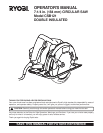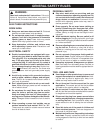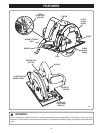
4
SPECIFIC SAFETY RULES
■ Check for misalignment or binding of moving
parts, breakage of parts, and any other condi-
tion that may affect the tool’s operation. If dam-
aged, have the tool serviced before using. Many
accidents are caused by poorly maintained tools.
■ Use only accessories that are recommended by
the manufacturer for your model. Accessories that
may be suitable for one tool, may become hazard-
ous when used on another tool.
SERVICE
■ Tool service must be performed only by quali-
fied repair personnel. Service or maintenance per-
formed by unqualified personnel could result in a risk
of injury.
■ When servicing a tool, use only identical replace-
ment parts. Follow instructions in the Mainte-
nance section of this manual. Use of unauthorized
parts or failure to follow Maintenance Instructions
may create a risk of electric shock or injury.
GENERAL SAFETY RULES
■ DANGER! Keep hands away from cutting area
and blade. Keep your second hand on the
auxiliary handle or motor housing. If both hands
are holding the saw, they cannot be cut by the blade.
■ Keep your body positioned to either side of the
saw blade, but not in line with the saw blade.
Kickback could cause the saw to jump backwards.
(Refer to “CAUSES AND OPERATOR
PREVENTION OF KICKBACK” later.)
■ Do not reach underneath the work. The guard
cannot protect you from the blade below the work.
■ Check lower guard for proper closing before
each use. Do not operate saw if lower guard does
not move freely and close instantly. Never clamp
or tie the lower guard into the open position. If
saw is accidentally dropped, lower guard may be
bent. Raise the lower guard with the retracting
handle. Make sure it moves freely and does not
touch the blade or any other part, in all angles and
depths of cut.
■ Check the operation and condition of the lower
guard spring. If the guard and the spring are not
operating properly, they must be serviced before
use. Lower guard may operate sluggishly due to
damaged parts, gummy deposits, or a buildup of
debris.
■ Lower guard should be retracted manually only
for special cuts, such as "Pocket Cuts" and
"Compound Cuts." Raise lower guard by
retracting handle. As soon as blade enters the
material, lower guard must be released. For all
other sawing, the lower guard should operate
automatically.
■ Always observe that the lower guard is covering
the blade before placing saw down on bench or
floor. An unprotected, coasting blade will cause the
saw to walk backwards, cutting whatever is in its
path. Be aware of the time it takes for the blade to
stop after switch is released.
■ NEVER hold piece being cut in your hands or
across your leg. It is important to support the work
properly to minimize body exposure, blade binding,
or loss of control.
■ Hold tool by insulated gripping surface when
performing an operation where the cutting tool
may contact hidden wiring or its own cord. Contact
with a “live” wire will also make exposed metal parts
of the tool “live” and shock the operator.
■ When ripping, always use a rip fence or straight
edge guide. This improves the accuracy of the cut
and reduces the chance for blade binding.
■ Always use blades with correct size and shape
(diamond vs. round) arbor holes. Blades that do
not match the mounting hardware of the saw will run
eccentrically, causing loss of control.
■ Never use damaged or incorrect blade washers
or bolts. The blade washers and bolts were specially
designed for your saw for optimum performance and
safety of operation.
CAUSES AND OPERATOR PREVENTION
OF KICKBACK
Kickback is a sudden reaction to a pinched, bound, or
misaligned saw blade, causing an uncontrolled saw to lift
up and out of the workpiece toward the operator.
When the blade is pinched or bound tightly by the kerf
closing down, the blade stalls and the motor reaction
drives the unit rapidly back toward the operator.
If the blade becomes twisted or misaligned in the cut, the
teeth at the back edge of the blade can dig into the top
surface of the wood causing the blade to climb out of the
kerf and jump back toward the operator.


















